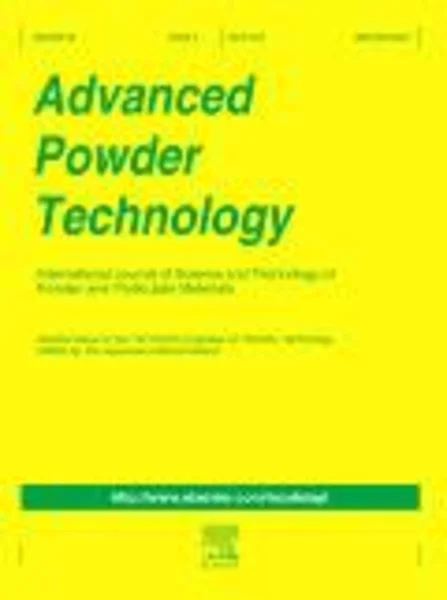-
molecular attributes of an effective steric agent: yield stress of dispersions in the presence of pure enantiomeric and racemate malic acids
جزئیات بیشتر مقاله- تاریخ ارائه: 1393/01/01
- تاریخ انتشار در تی پی بین: 1393/01/01
- تعداد بازدید: 612
- تعداد پرسش و پاسخ ها: 0
- شماره تماس دبیرخانه رویداد: -
the effects of ph on the yield stress and zeta potential behaviour of α-al2o3 dispersions with addition of d-, l- and racemate (dl) malic acids were evaluated. conformational structures and intramolecular hydrogen bonding of the adsorbed malic acids obtained via mm2 modeling were used to explain the surface forces operating in the dispersions. we found that the yield stress-ph behaviour is almost identical for d-, l- and racemate malic acids. at low surface coverage of adsorbed malic acid, the maximum yield stress was reduced by as much as 55%. at complete surface coverage the reduction decreased to ∼40%. mm2 modeling showed the presence of intramolecular hydrogen bonding between the hydroxyl and the (free) charged carboxylate group within the malic acid molecule. intra-molecular hydrogen bonding and the high number of strongly bound water molecules (hydration number of malic di-ionic species) were likely responsible for the di-ionic malic acid species acting as a very effective steric agent. at complete surface coverage, the inter-molecular hydrogen bond formed between the layers of adsorbed malic acid, is responsible for the small rise in the maximum yield stress. racemate malic acid produced a smaller maximum yield stress at complete surface coverage compared to the pure enantiomers. this may be related to the two different types of hydrogen bonds found in the racemate. only one type is found in the pure enantiomers.
مقالات جدیدترین رویدادها
-
استفاده از تحلیل اهمیت-عملکرد در ارائه الگوی مدیریت خلاقیت سازمانی و ارائه راهکار جهت بهبود
-
بررسی تاثیر ارزش وجوه نقد مازاد بر ساختار سرمایه شرکت های پذیرفته شده در بورس اوراق بهادار تهران
-
بررسی تأثیر سطح افشای ریسک بر قرارداد بدهی شرکت های پذیرفته شده در بورس اوراق بهادار تهران
-
بررسی تأثیر رتبه بندی اعتباری مبتنی بر مدل امتیاز بازار نوظهور بر نقد شوندگی سهام با تأکید بر خصوصی سازی شرکت ها
-
تأثیر آمیخته بازاریابی پوشاک ایرانی بر تصویر ذهنی مشتری پوشاک ایرانی (هاکوپیان)
-
مقایسه تغییرات همودینامیک ناشی از پروپوفول و تیوپنتال حین القای بیهوشی و لوله گذاری نای
-
فن شناسی و سبک شناسی حوضخانه های مساجد ایرانی اسلامی (نمونه موردی: حوضخانه های مساجد شهرستان مهاباد)
-
ارائه الگوریتم الکترومغناطیس برای مساله انتخاب تامین کننده چند هدفه چند محصولی با در نظر گرفتن تخفیف و رویکرد فازی
-
experimental and numerical study on air cores for cylindrical tank draining
-
the inspection of dimensions and geometry of disks on their dynamic stiffness using the cone model
مقالات جدیدترین ژورنال ها
-
مدیریت و بررسی افسردگی دانش آموزان دختر مقطع متوسطه دوم در دروان کرونا در شهرستان دزفول
-
مدیریت و بررسی خرد سیاسی در اندیشه ی فردوسی در ادب ایران
-
واکاوی و مدیریت توصیفی قلمدان(جاکلیدی)ضریح در موزه آستان قدس رضوی
-
بررسی تاثیر خلاقیت، دانش و انگیزه کارکنان بر پیشنهادات نوآورانه کارکنان ( مورد مطالعه: هتل های 3 و 4 ستاره استان کرمان)
-
بررسی تاثیر کیفیت سیستم های اطلاعاتی بر تصمیم گیری موفق در شرکتهای تولیدی استان اصفهان (مورد مطالعه: مدیران شرکتهای تولیدی استان اصفهان)
-
سنجش اعتماد اجتماعی و عوامل مؤثّر برآن، دربین کشاورزان شالیکار شرق استان گیلان (مورد مطالعه: آستانه اشرفیه)
-
فرآیند پیش نگری ، تاثیرات آن در عکاسی فتوشیمیایی و نحوه احیاء آن در عکاسی دیجیتال
-
بررسی تأثیر بازارگرایی و ابعاد آن بر عملکرد شرکتهای بیمه پاسارگاد در شهر تهران
-
سنجش نگرش و ادراکات دانشجویان و دانش آموختگان کارشناسی ارشد نسبت به نقش برنامه های درسی رشته تحصیلی خود در کسب مهارت های شغلی، انتظارات شغلی و شانس اشتغال آنها
-
بررسی عوامل تاثیر گذار بر تمایل به ادامه کسب و کار اینترنتی در بنگاه های کوچک و متوسط استان تهران




سوال خود را در مورد این مقاله مطرح نمایید :